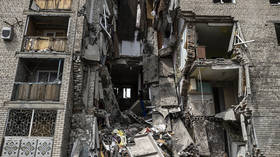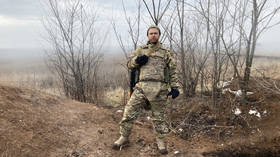
Moscow is hoping it will be third time lucky as the first anniversary of its offensive approaches

Russian servicemen are seen as they fire from 2A18 D-30 howitzers toward Ukrainian positions in the course of Russia’s military operation in Ukraine, at the unknown location. © Sputnik / RIA News
After the successful capture of Soledar, Russia has continued to advance in the the Donbass, with battles ongoing. To the south-west, Ugledar – a small mining town a hundred kilometers north of Mariupol – has become the main contact point for Moscow’s troops. If the Russians succeed in this offensive, it will be a significant blow to Ukraine. Potentially, a victory in Ugledar could change the balance of power in the Donetsk area and improve Melitopol’s defences.

Read more
Why is there such a focus on this area?
Another assault on Ugledar was launched on 24 January by Pacific Fleet Marines and special forces from the Donetsk People’s Republic (DPR). Although Russia made some gains in the early days of the operation and Ukrainian forces suffered heavy losses, little progress has been made in terms of land.
Ugledar is made up of a combination of four blocks of 1960s Soviet-era panel-built multi-storey buildings. It differs from more traditional cities in that there are no private houses within city limits. This makes Ugledar a compact fortress, not only on an elevated site, but with an additional 27 metres of built-up fortification.
These factors have made Ugledar a key part of the Ukrainian defense in southwest Donetsk. Kiev’s continued control of these positions allows its forces to have a grip on the surrounding area, preventing Russians from flanking Marinka, Kurakhovo and Avdeevka from the south. Also near Ugledar is an important section of the Donetsk-Volnovakha railway line, and the presence of Ukrainian troops near it prevents it from being used for military purposes.

Ugledar, Yuzhno-Donbasskaya mine. © Wikipedia
This is not Moscow’s first attempt to occupy the city
The Russian army’s first two offensives on Ugledar were unsuccessful. The current front line began to take shape in March, last year, after DPR troops broke through Ukrainian defenses at Volnovakha and Granitnoye to link up with Russian forces coming from Crimea. They achieved the strategic task of encircling Mariupol and creating a land corridor between Crimea and Rostov-on-Don. However, the battle for Mariupol delayed the Russian forces and prevented them from taking Ugledar and Velikaya Novoselka to the west.

Read more
For a long time, this section of the front was the scene of trench warfare and artillery duels. It placed the inhabitants of the villages in the area in a difficult position, dependent on humanitarian aid, the delivery of which was accompanied by regular shelling. A monastery in the village of Nikolskoye, near Ugledar, had become something of a humanitarian hub and shelter. However, it too was regularly bombed.
On June 22, the Ukrainian forces launched a counter-attack south of Ugledar, using their control of the high ground to occupy the village of Pavlovka. They failed to advance further than the village of Yegorovka, but this counter-attack was the beginning of a long period of positional fighting to the point of exhaustion. Battles continued throughout the summer in the forest belt between Pavlovka and Yegorovka. Both sides suffered heavy casualties, but the front line remained static until the end of October, when the Russians tried to retake Pavlovka.
This attack was not fully thought through. Although the battlefield eventually fell to the Russians, launching an offensive in muddy conditions was not a good idea. The attack on Pavlovka resulted in losses of armored vehicles and was accompanied by difficulties in evacuating the wounded and bringing in reinforcements. As a result, after about ten days of fighting, Pavlovka, below Ugledar, was under the Russian flag, but it wasn’t possible to continue the offensive further north. This experience was widely discussed in the military section of the Russian media, and the generals in charge were heavily criticized.
How the battles are going
Two months later, having prepared their forces for a sudden surge, the Russians launched a third battle for Ugledar. According to DPR official Aleksandr Khodakovsky, who took part in the fighting as part of a police unit, aerial images showed considerable confusion and disorganization in the enemy ranks.

© RT
Success was achieved with a breakthrough from the south-east through a dacha village near Nikolskoye, while the Ukrainians had based their defenses on the expectation of an attack from Pavlovka. As a result, within a few days the Russians had taken control of the dachas near Nikolskoye, the farms and the granary north of Pavlovka, and entered the south-eastern outskirts of Ugledar.
Kiev’s forces, in turn, restructured their defenses by retreating deeper into Ugledar and continuing to use the panel houses as strongholds. The Ukrainian military made the area of the Yuzhno-Donbasskaya Mine No. 1, north-east of Ugledar, the main concentration of reserves for counter-offensive actions.

Read more
Units of the 1st Tank Brigade, 35th Marine Division, and according to unconfirmed reports, the 80th Airborne Assault Brigade, were sent in to support the Ukrainians fighting there, in the 72nd Mechanized and 68th Yager Brigades. Thus, despite the lack of meaningful progress and a return to positional fighting, the Russians succeeded in straining Ukrainian reserves and moving them further away from Artemovsk/Bakhmut and Kremennaya, where the Russian offensive is now underway.
As of now, attempts by the Russian military to advance near Ugledar are continuing. According to an adviser to the acting head of the DPR, Igor Kimakovskyy, the settlement is partially surrounded.
***
Even in the event of success at Ugledar, a significant push by the Russian army northwards is unlikely, because it would be difficult once Ukraine has moved in reserves. However, Kiev would lose its key stronghold in the area and would be forced to retreat northward, losing a convenient bridgehead for an offensive against the Donetsk-Volnovakha highway and key positions for artillery.
By Vladislav Ugolny, a Russian journalist based in Donetsk




